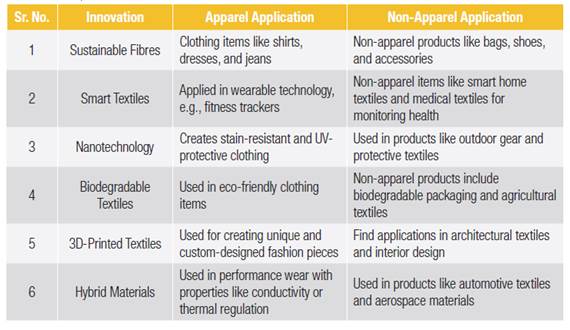Fashion technology plays a pivotal role in the apparel and clothing industry, significantly impacting the way we design, produce, and engage with both textile and non-textile products. Technological applications are revolutionising the industry, enabling designers to employ computer-aided design (CAD) and computer-aided manufacturing (CAM) software to craft innovative and distinctive designs, patterns, and crafts. This not only makes the design process more efficient and precise but also introduces a competitive edge.
In the realm of manufacturing and design, technology has brought about advancements through automation and robotics, allowing the adoption of sophisticated machinery. This transition leads to swifter and more cost-efficient production processes. However, the impact of technology is not confined to automation. The emergence of wearable technology, including smart fabrics and various forms of interactive clothing, is infusing new and unique dimensions into fashion styling, merging aesthetics with functionality.
In the context of e-commerce, an array of virtual try-on tools now enables consumers to shop with greater assurance and efficiency. In essence, fashion technology is not merely shaping the future of fashion but is also making it more accessible and exciting for everyone, enhancing the availability of goods and services from manufacturers and retailers. The synergies of fashion and technology and their intriguing developments are discussed below.
The Role of Technology in the Fashion Industry
Textiles and apparel have been central to human culture since time immemorial. In the modern era, the manufacturing of clothing and textiles, along with the broader fashion industry, plays a crucial role in the global economy. Consequently, technology has seamlessly integrated itself into the fashion sphere. The advancement of technology has not only impacted manufacturing and business practices but has also brought about a plethora of fashionable styles, influencing clothing trends worldwide.
Fashion influencers and industry analysts alike recognise the burgeoning role of technology in fashion, noting its significant impact on the global fashion market. Today’s fashion designers harness inspiration from a myriad of sources, transforming their unique visions into tangible garments through innovative ideas.
The Role of Technology in Material Innovations
In the pursuit of sustainable fashion and eco-friendly products, the modern fashion industry has adopted a more ethical and profitable approach to remain competitive. This shift is largely underpinned by technological advancements and research and development (R&D) initiatives, which are crucial for enhancing the production process, starting with material innovation.
Leading apparel brands such as Zara, H&M, Adidas, and Puma have integrated sustainable practices throughout their production stages. Consequently, fashion brands are continuously exploring new methods of producing sustainable clothing and non-textile materials. Profits are increasingly being generated through the use of sustainable raw materials and processes. These include the development of smart textiles, the application of nanotechnology, the creation of biodegradable textiles, and the innovation of hybrid materials. Each of these represents a significant step forward in the industry’s commitment to sustainability.
Table 1 shows applications of the innovations in textile raw materials for both apparel and non-apparel goods.
Table 1 Applications of Textile Innovations in Apparel and Non-Apparel Industries 
The Role of Technology in 3D Printing
3D printing is a transformative force within the fashion industry, offering numerous benefits that enhance availability and accessibility for consumers globally. This technology allows for an almost limitless scope of design and printing possibilities for both designers and manufacturers. It enables the combination of varied materials into a single layer, facilitating the production of a diverse range of fabrics with different properties tailored to customer requirements.
This technology is not confined to textiles alone; it is equally adept in producing non-textile products. Designers can push the boundaries of their creativity, while the customisation aspect of 3D printing allows fashion brands to craft apparel that fits the unique body shapes, sizes, and proportions of their customers.
Several key advantages of 3D printing in the apparel industry include:
Customised Clothing: 3D printing allows for the creation of custom-fit garments, significantly reducing waste and enhancing the fit and comfort for individual customers.
Diverse Geometries: This (3D printing) technology empowers designers to create complex textile structures, surpassing the limitations of traditional manufacturing methods.
Rapid Prototyping: Designers can quickly iterate and test new designs and concepts thanks to the swift nature of 3D printing.
Sustainability: A notable benefit of 3D printing is the reduction of fabric waste through precise garment layering. Some companies are utilising recycled plastics and advanced materials for 3D printed apparel, thereby improving sustainability.
Embedded Electronics: Smart textiles and garments embedded with electronics are prime examples of 3D printing applications, enabling the integration of sensors and other technologies into clothing. These smart garments aim to address functional needs innovatively.
These advancements, though significant, are just the beginning. Continuous innovation in 3D printing is set to further revolutionise the apparel and textile industry, making it more adaptable, efficient, and eco-friendly.
The Role of Technology from CAD to Machine Learning
The advent of computer science and information technology has catalysed a significant transformation in the fashion design process, contributing to the growth of the apparel industry. Computer-aided tools and techniques have empowered designers to bring their visions to life. The applications of CAD and CAM systems have elevated modern fashion design to new heights. Additionally, the incorporation of Artificial Intelligence (AI) and other technological advancements in this domain not only saves time and money but also accelerates the lead time, facilitating the creation of new designs with innovative styling.
The integration of CAD with Machine Learning is particularly influential in the apparel industry, reshaping design, production, and the consumer experience. Here are some key areas of impact:
Prototyping and Designing: CAD-CAM software has revolutionised the design process, enabling designers to create and adjust patterns and garments in a virtual environment. Tools such as Adobe Illustrator, Photoshop, and CorelDRAW are extensively used in apparel design. Machine Learning further enhances this process by analysing datasets to predict trends and customer preferences, thus aiding designers in crafting unique and market-relevant designs.
Pattern Designing and Cutting: CAD systems digitise and refine patterns for greater accuracy, which translates into more efficient cutting processes. Machine Learning algorithms can leverage historical data to refine pattern making, aiming to minimise fabric waste, reduce production costs, and enhance the productivity of the design and cutting departments.
Inventory Management: Machine Learning is pivotal in forecasting demand patterns to optimise inventory levels and production planning. Zara, for instance, utilises Machine Learning to manage its inventory effectively, enabling the brand to swiftly adapt to changing customer preferences.
Thus, the synergy of CAD and Machine Learning not only improves efficiency and personalisation, but also fosters sustainable practices within the apparel and textile industry.
The Role of Technology in Digital Clothing
In the current digital age, technology has drawn consumers towards digital personas and digital clothing, propelled by the diverse applications of AI and emerging technologies. Fashion brands now have the capability to discern consumer preferences and tastes with remarkable accuracy using available data sets. Moreover, digital social media platforms have transformed the landscape of serviceability. For example, companies like Amazon, Flipkart, and Myntra have all played pivotal roles in the realm of digital marketing.
Digital clothing represents an evolving trend within the fashion industry, offering consumers innovative ways to showcase their style and individuality within the virtual realm. A number of online platforms have risen to meet this new demand. Websites such as The Fabricant and Carlings provide opportunities for users to purchase and personalise digital garments for use in virtual reality environments. In parallel, platforms like Roblox and IMVU have established virtual marketplaces for buying, selling, and exhibiting digital clothing on avatars.
Social media platforms, encompassing applications, websites, user interfaces, and other forms of content, serve as conduits between fashion influencers and their audiences. These platforms stimulate the growth of both digital marketing and digital clothing, enabling influencers to introduce new styles, trends, and fashion lifestyles. Through these digital channels, customers can effortlessly shop for looks with just a click, further embedding digital clothing into the fabric of modern fashion consumption.
Top Fashion Technology Trends
Fashion technology trends refer to the manner in which advances in technology influence and shape fashion, clothing, and style, resulting in new and sought-after styles and choices of clothing and accessories. These trends encapsulate the interaction between technological progress and the evolution of fashion. The fashion and garment industry is projected to be worth up to $3.3 trillion by 2030, and hence understanding the various technological trends that influence and significantly impact fashion and styling is critical.
The influence of social media, visual merchandising, digital marketing, and advanced software for marketing purposes is considerable. These tools provide customers with easy access to the latest trends and products, appealing particularly to younger consumers who are eager to try products tailored to their specific needs and preferences. In a fast-evolving environment, where trends have a brief lifespan, it becomes challenging for manufacturing and fashion industries to continue producing large volumes. Implementing robust systems that harness data to forecast current and future fashion trends is essential to remain competitive.
Many brands and designers are focusing on integrating the latest technologies to overcome the limitations and challenges faced by manufacturing organisations. AI, for example, plays a pivotal role across various platforms such as mobile apps, e-commerce, blockchain, and other emerging technologies.
Let’s delve into the key trends in fashion manufacturing technology:
-
Novel Fabrics: The future of fashion includes innovative, eco-friendly, and distinctive fabrics. Companies like Modern Meadow are pioneering the creation of lab-grown leather, which avoids animal harm.
-
Internet of Things (IoT): In fashion, IoT signifies the integration of clothing and accessories with the internet. This includes everything from smart clothing to connected devices, and this trend is rapidly expanding.
-
Rapid Data Analysis: Agile data analysis is essential for businesses to adapt swiftly. It involves utilising extensive data to make prompt improvements.
-
Mobile Commerce: Shopping via smartphones has become increasingly accessible. Today, we can use digital wallets and social media for seamless shopping and transactions.
-
Virtual and Augmented Reality (VR/AR): VR and AR technologies are revolutionising online shopping by allowing customers to try on virtual outfits from the comfort of their homes. These experiences are so immersive that they can replicate the sensation of being in a physical store.
-
Online Vector Editors: For those looking to design fashion without specialised software, online editors such as Vectr are incredibly helpful. These user-friendly tools allow for the creation of unique designs without the need to draw from scratch.
-
AI-Based Inventory Management: Finally, AI, or intelligent software algorithms, are revolutionising inventory management. These systems not only monitor stock levels but also predict customer demands, ensuring that warehouses are efficiently organised.
These are just some of the emerging trends that are reshaping the fashion industry through the use of cutting-edge technology.
Application of AI in the Fashion Industry
Artificial Intelligence (AI) extends its influence beyond manufacturing and various business sectors, playing a significant role in fashion brand building. Numerous apparel and fashion brands have embraced AI to enhance production processes, data analytics, increase sales, forecast trends, manage inventory effectively, and provide better shopping experiences to consumers. AI is built on algorithms and datasets that track the customer journey, including their needs, preferences, search history, and other significant interactions. Moreover, machine learning is utilised to generate trends based on this vast array of data.
In retail, AI-powered chatbots and interactive touchscreens are deployed to offer personalised services and product recommendations. Chatbots aid in brand building by enhancing the shopping experience and improving customer service. They are capable of predicting trends and managing the supply chain, which is pivotal for any industry. Real-time inventory tracking, a crucial element for brands, is made more efficient with AI, saving time and streamlining warehouse operations.
AI’s predictive capabilities are used for trend forecasting, giving brands a competitive advantage. This shifts the reliance from traditional methods, which depended on fashion designers and trend spotters, to AI that provides immediate data to plan styles and quantities more effectively. For instance, Stitch Fix, a British fashion label, utilises automated wardrobe planning with analytics to curate a virtual wardrobe for its customers. TrueFit offers an online fitting engine to help users find the perfect fit with brands and new styles.
Smaller retail technology companies like Edited and Intelligence Node deliver real-time data and tools for tracking trends. Live streaming has become mainstream on platforms such as Instagram, Facebook, and Twitter, bolstered by 5G technology, allowing customers to virtually try on designs before purchasing. Fashion houses like Tommy Hilfiger and Gucci have developed digital showrooms, and online eyewear retailers such as Firmoo enable customers to visualise frames on their faces before buying.
Historically, trend forecasting was based on past trends, but AI now leverages social media, current and historical databases, and image recognition to predict future trends. Firms like Heuritech and collaborations between Google and institutions like the Fashion Institute of Technology (FIT) employ these advanced techniques for real-time trend analysis.
In short, AI is transforming the fashion industry by redefining trend prediction and revolutionising the consumer shopping experience.
Conclusion
The amalgamation of fashion and technology has profoundly redefined the apparel and clothing industry. Innovations ranging from CAD and CAM systems to the creation of sustainable materials have been instrumental in revolutionising design and manufacturing methodologies. Developments such as sustainable fibres, intelligent textiles, nanotechnology, biodegradable fabrics, 3D printing, and hybrid materials have significantly contributed to creating an environmentally friendly and efficient fashion sector.
3D printing, in particular, has unleashed potential for customisation and rapid prototyping, thereby curbing waste and promoting sustainability. Additionally, the advent of digital clothing, powered by AI and propelled by social media, has introduced an entirely new facet to the fashion experience. This has allowed consumers to showcase their personal style within virtual realms, with platforms providing digital garments and facilitating virtual marketplaces.
Fashion brands have embraced AI to refine production processes, analyse data, anticipate trends, streamline inventory management, and augment the overall shopping experience. Tools such as chatbots, interactive touchscreens, and real-time inventory management systems have become indispensable, enabling brands to swiftly adapt to fluctuating market trends. AI has redefined trend forecasting through its capacity to process extensive datasets from social media and other current databases, steering the fashion industry towards a revolutionary path.
The intersection of fashion and technology, so far, is a testament to a thrilling progression, hinting at the vast possibilities awaiting the future of this vibrant industry.


 (1)20240730094415.jpg)







Comments